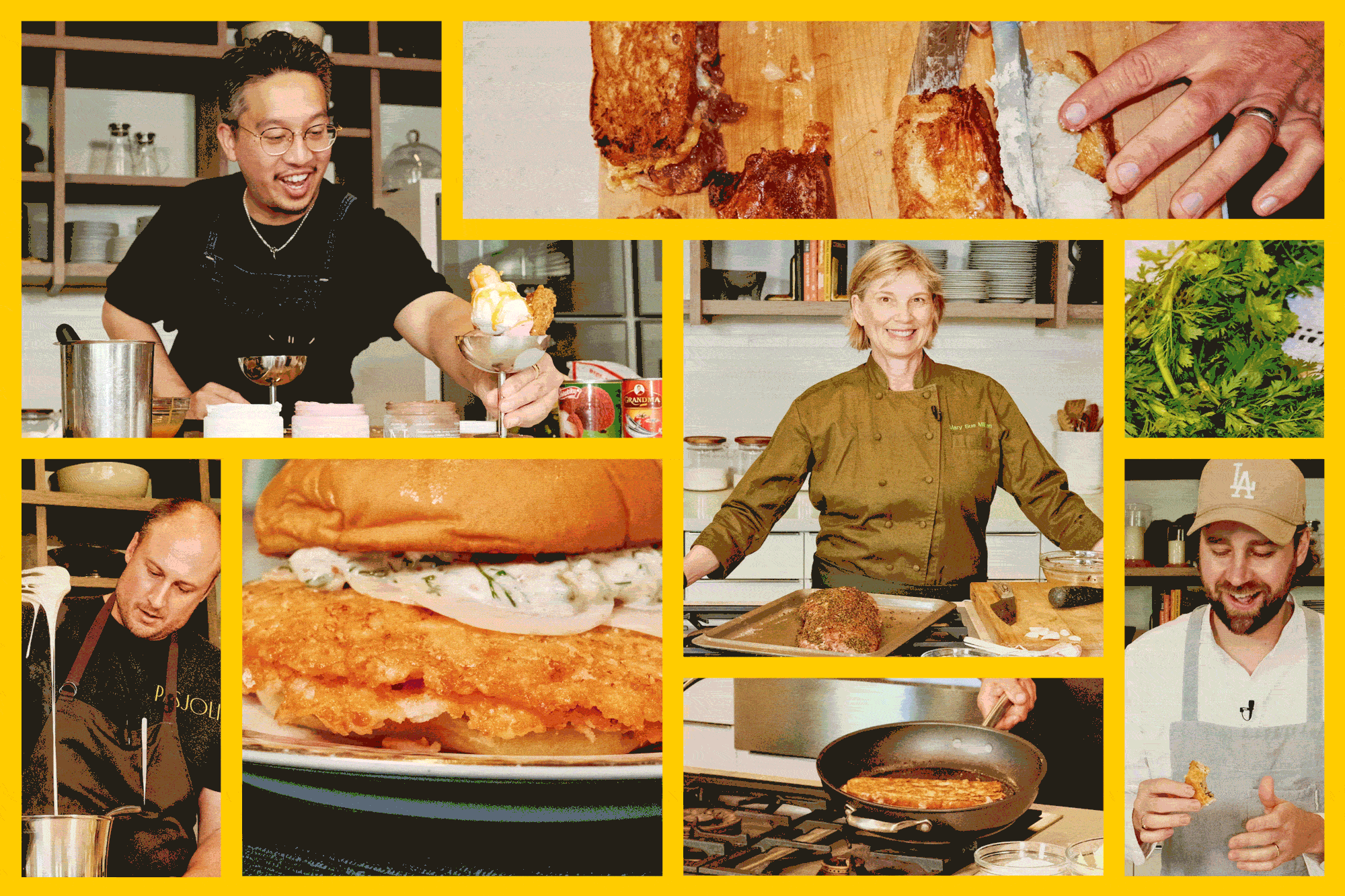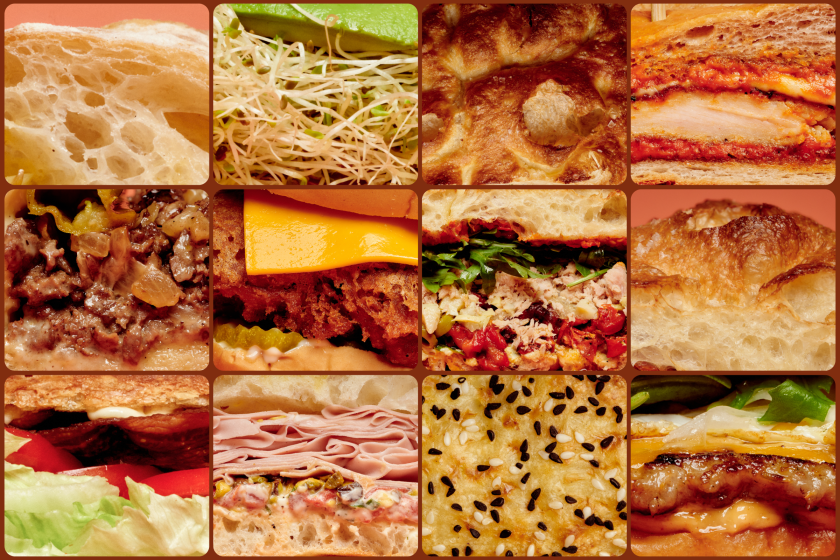The unlikely revolutionary
The dishes are breathtaking, one after another: an astonishingly unctuous square of braised pork belly set off by a jewel-like bouquet of crisp cooked vegetables. The sweet ocean flavor of flash-fried shrimp, accented by the rich, nutty taste of toasted oatmeal. Thinly sliced, perfectly cooked broccoli stems, artfully arranged on a platter of ice and ready to dip in a piquant sauce--”vegetable sashimi,” it’s called. A spinach dough that turns one bit of pastry such a vivid green, it looks like an intricately folded cloisonne pin.
It’s food that you can almost imagine being served in the hushed, minimalist dining room of an ultra-modern French restaurant. But this is an ordinary, bustling restaurant on a commercial strip of the San Gabriel Valley, a 6-month-old Chinese spot with an expressly utilitarian name: New Concept.
Still, it just might be the start of a revolution. Until now, Chinese cooking in the United States has pretty much focused on a narrow range of classics. Restaurants specialize in the traditional dishes of a single region, and strive night after night to perfect them.
New Concept marks a radical departure. Its dishes are fresh and inventive, and drawn from all over China and even beyond--a long riff influenced by the East and West, written in Chinese, English and French and not above a hint of whimsy. Soda Pop Flavored Chicken Wings, anyone?
But the most important difference is one that most non-Chinese may not even notice: Chef Chen Chen Liang’s name appears on the menu.
While this kind of publicity may be the norm in ambitious dining rooms everywhere else, it is simply not done in the Chinese restaurant world. Here chefs traditionally are regarded as nameless, faceless workers, known only to their employers and the most inquisitive of foodies.
By placing Chen front-and-center, New Concept is positioning him to become the first Chinese star chef in the United States. In the more traditional world of Chinese cooking, it is a daring maneuver--and one whose success is anything but assured.
Chen is certainly off to a good start. Although New Concept has been open only since December, Los Angeles Times critic S. Irene Virbila already has given the restaurant a rare three-star rating, calling it “the place of the moment” for those “who really know Chinese food.”
The restaurant is packed. And the two private dining rooms, where banquet menus can run $180 a person and up, are fully booked. Lunch is even more popular. Lines often run out the door for the innovative dim sum that Chen creates with chef Tom Lu.
Chinese restaurant maven Carl Chu, author of “Chinese Food Finder: Los Angeles,” says Chen’s visibility “is groundbreaking, if they’re willing to stick to it.
“For the Chinese, there are still some cultural barriers that are going to have to be overcome,” he says. “I’m Chinese and I know how deep that goes, but it could work. It’s possible that the younger generation like me, which has been brought up in the Western style, will be more open to appreciating a chef who’s taking a starring role.”
so who is this guy who is changing the face of Chinese cooking in Los Angeles? Sitting in the dining room, answering questions, Chen seems a most unlikely revolutionary. He listens patiently and answers quietly, referring now and then to his kitchen notebook, where the specifics of dishes are annotated in perfect columns of precisely marked Chinese characters.
The 51-year-old Chen has been in this country for less than a year and is still struggling with English. For translation, he relies on restaurant manager Gary Ye, born in mainland China yet almost startlingly fluent in vernacular American English (“I learned everything from listening to Chick Hearn,” he says).
No Western, media-groomed glamour boy, Chen looks, frankly, more than a little worn out. There is a blaze of white in his black hair and his eyes are slightly bloodshot.
He seems infinitely more comfortable at the stove, where he can be found most nights manning the No. 1 wok position, the one that handles the most expensive ingredients and trickiest dishes.
Chen started cooking at 16. As the oldest of eight children, he had to work to help the family. And since he had an uncle in the restaurant business in Hong Kong, the choice of careers was easy.
The turning point in his life--both personally and professionally--came when he was in his late 20s. Until then, cooking had been little more than a job, something he could do to put food on the table. Then, almost on a whim, he followed a friend to Germany, where he helped open a Chinese restaurant.
His time in Europe was pivotal, in more ways than one. Personally, the move was transforming. “I was at that age when most men are starting to get some maturity; they’re getting married, starting a family,” Chen says. “I thought at that time that I didn’t want to be moving around all the time, like a leaf floating on water. That’s when I started thinking that being a chef would be my major goal in the future. I wanted to be in one place doing one thing and starting a family.”
But the time in Germany marked a professional turning point as well. Chinese chefs rarely venture far from home, according to cookbook writer and Chinese food authority Ken Hom. “The problem with a lot of Chinese food is that the chefs might be very skilled technically, and what they do is perfect, but they don’t have the inventiveness of someone like Nobu [Matsuhisa],” Hom says.
“Their worldview is very shortsighted. They haven’t traveled a lot outside of their own country, even within Asia--really, even within China. Their grasp of ingredients is confined only to their region.”
But Chen was curious about food and hit the road whenever he could while in Germany in order to explore the cooking of other countries. “That was the key to making me think about which direction Chinese food should go,” Chen says. “It could stay in the old-fashioned way, or it could change.
“One major difference between Asian restaurants and Western ones is that in Asia, except for a few places, the restaurant’s major function is just to feed people. After traveling in Europe, I saw that there were other possibilities that might work with Chinese cooking.”
That determination to practice cooking as an art is evident on the New Concept menu, which freely mingles ingredients and dishes from all over the East and West.
Chen’s much-commented-on shrimp with oatmeal started in Germany as a twist on Chinese rice porridge. At first he simply tried to spike normal oatmeal porridge cooked in milk with shrimp. (“A Cantonese chef’s first thought is always to add seafood,” he says with a smile.)
Then he thought about making the oatmeal stiffer and using it as a batter for frying the shrimp. Still, he couldn’t get the rich toasted oat flavor he was looking for to complement the seafood. Finally he decided to fry the shrimp separately and garnish it with oatmeal flakes that he had dry-fried in a wok.
Like all great dishes, this one works on a number of levels. Intellectually, it is intriguing: What in the world is oatmeal doing in a Chinese dish and what could it possibly have in common with the shrimp? Taste it, and the sensual reply is immediately obvious in the way the oats point up both the sweetness of the shrimp and the golden flavor of the frying.
More subtle, but just as effective, is the dim sum pairing of creamy, delicate fresh turnip cake--the very essence of hominess--with rich, slightly spicy XO sauce, a concoction usually reserved for luxurious seafood such as abalone or lobster. It’s a creative high-low pairing worthy of Alain Ducasse, and even though it is a surprising combination, it seems deeply authentic, as if the two had been cooked together for generations.
“The main thing I want to do in this period of my life is to introduce the real Chinese foods to the Western world,” Chen says. “Not only to Chinese people, but to help the Western world realize what we have. Chinese food is so huge, it’s hard to realize how much there is.”
And if, in the process, he brings Chinese chefs out of the shadows, too, so much the better.
More to Read
Eat your way across L.A.
Get our weekly Tasting Notes newsletter for reviews, news and more.
You may occasionally receive promotional content from the Los Angeles Times.









